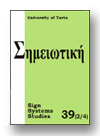
Sign Systems Studies
Scope & Guideline
Unlocking the Secrets of Meaningful Communication
Introduction
Aims and Scopes
- Semiotic Theory and Analysis:
The journal is dedicated to the development and application of semiotic theories, particularly those stemming from key figures like Ferdinand de Saussure and Juri Lotman. It explores the mechanisms of signification and the implications of semiotics in understanding communication. - Interdisciplinary Approaches:
Sign Systems Studies encourages interdisciplinary research that integrates semiotics with fields such as linguistics, cognitive science, aesthetics, and cultural studies. This broad approach allows for diverse methodologies and perspectives on semiotic phenomena. - Cultural Semiotics:
A significant focus is placed on cultural semiotics, examining how signs operate within various cultural contexts. The journal publishes work that analyzes the semiotic dimensions of literature, art, religion, and media, among others. - Biosemiotics and Ecosemiotics:
The journal increasingly addresses biosemiotics and ecosemiotics, exploring the relationship between living organisms and their environments through the lens of sign processes. This area emphasizes the role of meaning-making in ecological contexts. - Historical and Epistemological Perspectives:
There is a consistent interest in the historical development of semiotic thought and its epistemological implications. Papers often reflect on the legacy of semiotic theorists and the evolution of ideas within the field.
Trending and Emerging
- Multimodal Semiotics:
There is a growing interest in multimodal semiotics, which examines how different modes of communication—such as visual, auditory, and textual—interact to create meaning. This trend is particularly relevant in the context of digital media and contemporary art. - Ecosemiotics and Environmental Semiotics:
Research focusing on ecosemiotics is on the rise, highlighting the relationship between semiotic processes and ecological systems. This theme is increasingly important as scholars explore how meaning is generated in natural contexts and the implications for environmental discourse. - Cognitive and Evolutionary Semiotics:
Emerging themes in cognitive and evolutionary semiotics are gaining traction, as researchers investigate the cognitive processes underlying signification and the evolutionary implications of semiotic behaviors in both human and non-human organisms. - Religion and Semiotics:
The intersection of religion and semiotics is becoming a prominent theme, with studies examining how semiotic theories can elucidate religious texts, practices, and cultural phenomena. This reflects a broader interest in understanding spirituality through semiotic lenses. - Digital and Media Semiotics:
The journal is increasingly publishing on topics related to digital and media semiotics, exploring how signs function in digital environments, including social media, virtual realities, and new communication technologies. This trend highlights the relevance of semiotics in contemporary society.
Declining or Waning
- Traditional Structuralism:
There seems to be a decline in the emphasis on traditional structuralist approaches, particularly those strictly adhering to Saussurean models of language and signs. Recent publications suggest a movement towards more dynamic and contextual interpretations of semiotics. - Purely Linguistic Semiotics:
Research focused solely on linguistic semiotics has decreased, as the journal increasingly embraces multimodal and interdisciplinary analyses that incorporate visual, auditory, and other forms of communication. This shift reflects a broader understanding of semiosis beyond language. - Static Interpretations of Culture:
There is a waning interest in static interpretations of culture that do not account for the dynamic and evolving nature of meaning-making. The journal is moving towards more fluid and process-oriented theories that better capture cultural transformations. - Overemphasis on Historical Figures:
While foundational semiotic theorists remain important, there appears to be a declining focus on solely historical analyses of these figures, with a growing interest in contemporary applications and new theoretical developments.
Similar Journals

Enthymema-International Journal of Literary Criticism Literary Theory and Philosophy of Literature
Exploring the Depths of Literary ThoughtEnthymema - International Journal of Literary Criticism, Literary Theory and Philosophy of Literature, published by Milano University Press, is a leading open-access platform dedicated to the dynamic fields of literary criticism and theory as well as the philosophy surrounding literature. With an ISSN of 2037-2426, this esteemed journal has been fostering scholarly dialogue and innovative discourse since its inception in 2009. As a member of the prestigious Q2 quartile in the Literature and Literary Theory category as of 2023, Enthymema ranks favorably within the Scopus framework, currently positioned at #599 out of 1106 journals, reflecting a robust engagement with current academic trends. The journal emphasizes inclusivity and accessibility, ensuring that cutting-edge research and critical insights are available to a wider audience without financial barriers. With its significant focus on contemporary debates and theoretical advancements, Enthymema serves as an essential resource for researchers, professionals, and students eager to navigate the intricate landscapes of literary studies.

Vestnik Sankt-Peterburgskogo Universiteta-Yazyk i Literatura
Illuminating the Intersections of Language and Literary ThoughtVestnik Sankt-Peterburgskogo Universiteta-Yazyk i Literatura, published by ST PETERSBURG UNIV PRESS, stands as a pivotal academic journal in the fields of linguistics and literature, reflecting a profound commitment to the exploration of language and literary theory. With an ISSN of 2541-9358, this journal has steadily built its reputation since its inception in 2017, achieving impressive rankings in Scopus that place it within the top tiers of its categories—Q2 in Linguistics and Language and Q1 in Literature and Literary Theory as of 2023. The journal serves as an essential platform for researchers, professionals, and students who are keen to delve into the complex interactions between language and literature. Although currently not offering Open Access, its contributions are invaluable to advancing scholarly dialogue and fostering understanding within these vibrant fields. With a converged publication timeline extending through 2024, Vestnik Sankt-Peterburgskogo Universiteta-Yazyk i Literatura exemplifies the ongoing commitment to high-quality research and critical thought, making it an indispensable resource for those dedicated to the study of language and its literary manifestations.

Archivum
Fostering Innovation in Linguistic and Literary StudiesArchivum, published by UNIV OVIEDO in Spain, stands as a vital resource in the fields of Linguistics and Language as well as Literature and Literary Theory. With an impact factor reflective of its commitment to scholarly excellence, this journal has proudly maintained an Open Access model since 1951, ensuring that its rich repository of knowledge is freely available to researchers, professionals, and students alike. Covering a converged span from 2019 to 2023, Archivum has strategically positioned itself within the academic milieu, currently categorized in the Q4 for Linguistics and Language and Q3 for Literature and Literary Theory as of 2023. The journal is indexed in Scopus, with rankings that reflect its growing influence, such as #690 in Literature and Literary Theory and #887 in Language and Linguistics. Despite its challenges in visibility, Archivum remains essential for those seeking to engage with contemporary discussions and research within the humanities. Located in the heart of Asturias, it embodies the scholarly spirit of Spain, fostering a collaborative environment for innovation and inquiry in linguistic and literary studies.
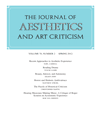
JOURNAL OF AESTHETICS AND ART CRITICISM
Fostering Interdisciplinary Dialogues in the ArtsThe Journal of Aesthetics and Art Criticism, published by Oxford University Press, stands as a premier platform for scholarly discourse in the realms of music, philosophy, and the visual and performing arts. Established in 1996 and continuing through 2024, this journal has achieved remarkable recognition, being ranked in the Q1 category across several disciplines, and securing prestigious positions in various Scopus rankings: 29th in Music, 50th in Visual Arts and Performing Arts, and 151st in Philosophy, showcasing its essential contribution to arts and humanities scholarship. While not an open-access journal, its rich repository of articles offers invaluable insights for researchers, professionals, and students alike, fostering a deeper understanding of aesthetics and critical theory. The journal's commitment to interdisciplinary approaches opens pathways for innovative dialogue, making it an indispensable resource for anyone engaged in the study and appreciation of the arts.

Cultura Lenguaje y Representacion-Revista de Estudios Culturales de la Universitat Jaume I
Fostering Innovative Research in Cultural CommunicationCultura Lenguaje y Representacion - Revista de Estudios Culturales de la Universitat Jaume I is a premier open-access journal dedicated to the exploration of cultural studies, linguistic discourse, and literary theory, published by the esteemed Universitat Jaume I. Since its inception in 2004, the journal has consistently aimed to provide a vibrant platform for interdisciplinary research and critical reflection within the fields of communication, literature, and cultural representation. With its impressive rankings in the Scopus database—placing in the 93rd percentile for Literature and Literary Theory and the 73rd percentile for Cultural Studies—this journal is recognized for its impactful contributions to academic discussions. Operated out of Castelló de la Plana, Spain, the publication not only welcomes contributions from seasoned scholars but also encourages emerging researchers to submit innovative works. By maintaining a dedication to accessibility and quality, Cultura Lenguaje y Representacion positions itself as an essential resource for scholars, practitioners, and students seeking to deepen their understanding of the intricate relationship between culture, language, and representation.

Rivista Italiana di Filosofia del Linguaggio
Illuminating the Intersections of Language and MindRivista Italiana di Filosofia del Linguaggio is a prominent academic journal dedicated to the exploration of linguistic philosophy and its intersections with various fields of study, such as linguistics, cognitive science, and semiotics. Published by UNIV STUDI CALABRIA, this journal seeks to foster scholarly discourse and critical analysis by providing a platform for innovative research and theoretical perspectives. With an expectation of rigorous peer review, the journal welcomes contributions that dissect the intricate relationship between language and thought, promoting a deeper understanding of linguistic phenomena. Although Rivista Italiana di Filosofia del Linguaggio operates under a traditional subscription model, its commitment to high-quality scholarship makes it a vital resource for researchers, professionals, and students alike who are engaged in the burgeoning field of linguistic philosophy. Based in Italy, and specifically located at CAMPUS ARCAVACATA, VIA PIETRO BUCCI, ARCAVACATA DI RENDE CS 87036, this journal continues to expand its international reach by attracting contributions from diverse academic backgrounds.
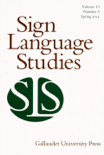
Sign Language Studies
Unveiling the complexities of signed communication.Sign Language Studies is a prestigious peer-reviewed journal dedicated to advancing the field of sign language research and the linguistic studies surrounding it. Published by Gallaudet University Press, this journal stands out in the realms of Linguistics and Language, being classified within the Q2 category as of 2023, which underscores its influence and relevance within academic circles. Operating under the ISSN 0302-1475 and E-ISSN 1533-6263, the journal has a remarkable Scopus ranking that positions it in the top 20% within the disciplines of Arts and Humanities and Social Sciences, attesting to the high quality and impact of its publications. Spanning a comprehensive timeline from 2002 to 2024, Sign Language Studies invites researchers, professionals, and students to engage with cutting-edge research, theoretical frameworks, and practical studies that contribute to our understanding of sign languages, their structure, use, and the communities they serve. This makes it an essential resource for those committed to the exploration and appreciation of sign language within both linguistic and social contexts.
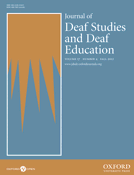
Journal of Deaf Studies and Deaf Education
Transforming educational outcomes for the deaf community.The Journal of Deaf Studies and Deaf Education, published by Oxford University Press, is a leading scholarly resource that focuses on the multifaceted realm of deaf studies, encompassing linguistic, psychological, educational, and social dimensions related to deafness and hearing impairments. With an impactful presence in both the Education (Q2) and Speech and Hearing (Q2) categories, this journal serves as a critical platform for disseminating innovative research and fostering discourse among professionals, educators, and scholars from across the globe. The journal is indexed in high-reputation databases and ranks prominently within the Scopus rankings, indicating its relevance and influence in the fields of Health Professions and Social Sciences. Published quarterly, the journal facilitates comprehensive access to groundbreaking studies and theoretical advancements that aim to improve educational methodologies and outcomes for deaf and hard-of-hearing individuals. As it celebrates two decades of impactful publication from 2004 to 2024, the Journal of Deaf Studies and Deaf Education continues to champion the scholarly pursuits aimed at enhancing understanding and support for the deaf community.

Cadernos de Estudos Linguisticos
Advancing linguistic frontiers through open dialogue.Cadernos de Estudos Linguisticos, published by UNIV ESTADUAL CAMPINAS, INST ESTUDOS LINGUAGEM, stands as a pivotal platform in the field of linguistic studies since its inception in 1978. With its commitment to Open Access, this journal fosters the dissemination of cutting-edge research, ensuring that knowledge is accessible to a global audience. This also enhances collaboration among researchers, professionals, and students dedicated to exploring the nuances of language. The journal proudly carries the ISSN 0102-5767 and E-ISSN 2447-0686, attesting to its uninterrupted quality and relevance in linguistic scholarship. By addressing various facets of language studies, including syntax, semantics, and sociolinguistics, this esteemed journal is a vital resource for advancing understanding and innovation in the field.
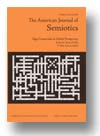
AMERICAN JOURNAL OF SEMIOTICS
Transforming Understanding Through SemioticsThe American Journal of Semiotics is a pivotal publication in the field of semiotic studies, focusing on the intricate relationships between signs and meanings across various disciplines. Published by the Philosophy Documentation Center, this journal disseminates vital research and theoretical advancements that contribute to a deeper understanding of language, communication, and cultural interpretations. Although the journal has had a period of coverage in Scopus from 1996 to 2018, it continues to hold relevance with notable rankings in the Arts and Humanities and Social Sciences categories, showcasing its diverse scholarly impact. The journal aims to engage researchers, professionals, and students through a rigorous exploration of semiotic theory and its applications, reinforcing its position as a significant resource in the academic landscape.